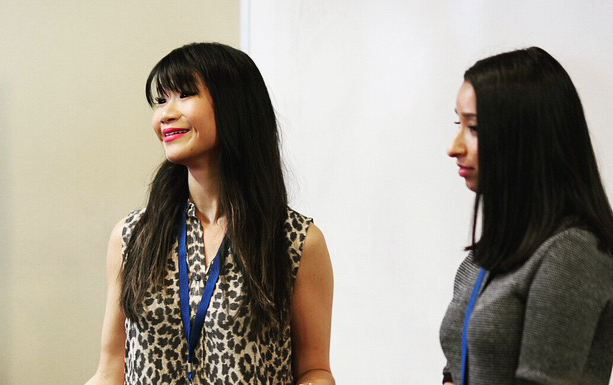Our head of social engineering Solange Rubio and Julie Lee of Julie’s Kitchen
We knew that folks in the advertising, media, and marketing industry are very interested in the burgeoning field of influencer marketing. But, we were still very surprised and honestly flattered to see such a big turnout today at our Influencer Campaign Cheat Sheet masterclass session on day one of Social Media Week Los Angeles (SMWLA June 8-12, 2015).
For those conference attendees who could not make into to the class (sorry guys…the room was literally so packed that one could barely find a place to sit down on the floor) and for those of you who are curious about the event, we are here to fill you in with all the highlights and can’t-be-missed details! Our head of social engineering Solange Rubio shared with the audience five key insights she gleaned from working with over 800 brands spanning across a diverse array of industries including food, fashion, travel, and non-profit. Joining her is the talented food stylist and influencer Julie Lee of Julie’s Kitchen — winner of Saveur Magazine’s 100 Best and master hand behind the famous food collage photography featured inApple’s Shot On iPhone 6 campaign. Having collaborated with a variety of brands such as Disney, Lexus, and Paypal, Julie offered invaluable advice from an insider’s perspective on how brands and agencies can better work with content creators.
Julie Lee’s famous food collage photography, which has been featured in Apple’s Shot On iPhone 6 Campaign
1. “The Better Your Social Profile, The Better Your Conversion Rates.”
Brands should build their own social influence first, before embarking on influencer marketing campaigns. Sponsored posts usually drive a good amount of traffic to brands’ own social channels, but the least thing you want is to turn off these already interested new visitors with bland content. Rather, brands should strive to build out a conversion funnel that looks something like this: first, people discover your brand or new offerings through influencers; then, they visit your social profile which reinforces what they’ve seen from influencer-created posts; after that, they opt-in and subscribe to consume your own content; finally, they buy your product and become an advocate. More importantly, a strong social presence appeals to influencers. By “influencing” the influencers to be truly passionate about your brands, you stand to foster a long-term relationship with them beyond one-off campaigns. As Julie said, “I like to work with brands that not just sell stuff, but know how to have fun with content.”
2. Don’t Match By Categories Or Verticals But By Your Audience’s Demographics And Behaviors.
We educate this to our clients all the time — being a bank or a consumer electronics company doesn’t mean your only option is to work with finance or tech influencers. If you are targeting female partygoers aged 18-35 who live in Los Angeles, then any influencer whose major audience is such could be your potential content collaborators. Case in point: Julie as a food blogger also works with PayPal and Lexus because her followers, people who love organic food, generally have more disposable income and are more finance-savvy. This is why finding the right platforms that help you sort through the influencers and analyze their followers’ breakdowns is especially important.
3. Do Your Research, Get Personal, And Respect Influencers’ Own Brands.
When brands reach out to influencers, the most common mistake they tend to make is not to do enough homework. “Dear influencer” is not the way you should address influencers and “I tried your recipe” is disingenuous if you can’t elaborate more. Popular influencers get tons of requests on a daily basis, and only by approaching them in a respectful and honest way can you win their interests. Remember, influencers are not puppet press agents; they have distinct brand voices of their own and people follow them because of their unique personalities. Solange suggested that brands should refer to past projects of content creators when pitching to them. By doing so, it shows that you value the works they’ve done and you have taken the time to appreciate their content.
4. Directions Are Good, But Prompts Are Better.
Brands sometimes try so hard to stick to their brand messages that they risk stifling the creativity from content creators. Rigid directions such as “hold this in your hand” and “take a picture with a bunch of friends” usually lead to less engaging content than soft prompts like “talk about your memories” and “give off a high fashion vibe.” This is because influencers love to get as much involved in the creative process as possible and the content developed in such a way is more organic and of a lasting impact. Intangible guidelines are particularly important if you are collaborating with a portfolio of influencers — imagine the variety of creative expressions that will come out versus a boring roster of pictures with the same postures. Last but not least, whenever influencers confide in their fans their personal stories, beliefs, and values, fans always respond feverishly.
5. Create A Successful Campaign On A Massive Scale.
According to the book GROUPED , people talk about 70 brands a week as conversation fillers, so brands would need to be out there as much as possible in order to get mentioned. Sometimes, brands would say “I just want to work with influencer X.” It’s good to have such a niche focus, but you will end up targeting only a single audience base. And don’t forget, people rarely just follow one influencer on Instagram or Vine. If you could partner with a nice mix of content creators specializing in different areas, you would get more diversified content as well as multiplying exposure. Contact us to see how our platform and #TeamInstaBrand can help you.






